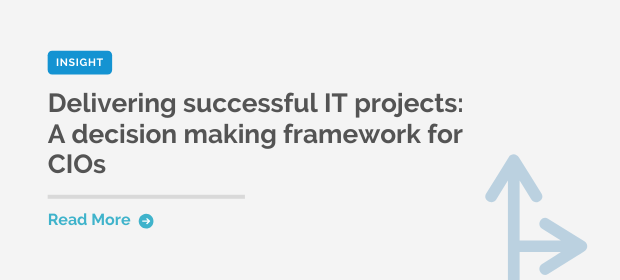Technological progress is commercial progress. And your ability to deliver profit-first transformational solutions on time and within budget is paramount to success.
But the challenge is complex. Whether your focus is automation, legacy systems, supply chain efficiencies or customer experience, you’re operating in an environment which saw 7-10 counterparts cancel projects in 2018 with each business wasting £1 million in the process (The FinTech Times).
Sourcing, assessing and selecting the right people to deliver technical change is rightly a preoccupation for many operational leaders. It’s one of the hardest decisions IT leaders will make in 2019. And when you’re bound by budget, regulation and often bureaucracy, it’s right to be risk-averse.
In today’s dynamic talent ecosystem, you have many options. Build a team in-house, call in the contractors, outsource to onshore, nearshore or offshore suppliers, or choose a blended approach. Which leads to success?
The truth is, all these resourcing options hold potential.
The trick is, finding which works best for you.
Focusing on an outsourced collaborative development process with an onshore supplier, here we weigh up the benefits against in-house IT.
What is an outsourced collaborative development process?
Working with an external technology partner, you’ll be engaging with a business to collaboratively develop single or multiple technology solutions.
Initially, a partner should offer engagement models to suit your business and project set up. Different options tend to include working to a fixed budget or the provision of a dedicated team.
A fixed budget engagement will see your partner work with you to scope out your needs and establish set expenditure for your software development project.
In a dedicated team engagement, your partner will provide you with a skilled team with abilities aligned to your needs. That development team will facilitate all aspects of project delivery and operational requirements and can then integrate with your existing team or work directly with stakeholders to deliver and maintain your applications.
Market-leading suppliers will use proven, industry-standard Agile processes to deliver against your requirements within a defined timescale and budget.
When is an outsourced partner better than in-house IT?
When a business critical project needs specialist knowledge
A technology partner brings a knowledge pool of cross-industry experience. Which provides the perfect mix of expertise to build a solution for your complex project. This makes partnering a more rapid and reliable solution than an existing or new in-house team.
Experience delivers time and cost efficiencies, and the often innovative nature of software development companies means smart, scalable and future-proofed software applications.
Compare this to relying on in-house expertise which, while excellent, may have been recruited in a different time and paradigm. This can mean that they have detailed knowledge of older technologies but lack expertise in newer systems. Understanding the gaps in knowledge within your team is the first stage in your decision making process.
When there’s a recruitment drive that isn’t optimised
Attracting, on-boarding and retaining talent takes time, money and effort and even when delivered as a managed service or outsourced to a recruitment firm, the wait for skilled personnel can leave gaping holes in your talent bank. It’s a good idea to strike a balance between increasing permanent headcount to cover short term projects and bringing in contractors who can take a lot of your domain network knowledge with them when they leave.
Given the IT skills shortage, it’s unlikely that you’ll have a bench of skilled, proven contractors waiting in the wings. In this case, collaborate with a specialist software development partner to instantly furnish your business with the knowledge and bandwidth to deliver.
When you need speed and agility
If you’re considering skilling-up your in-house team, you’ll know new employees rarely hit the ground running. There will be a myriad of internal processes for them to go through before they can dedicate their focus to the project in hand.
A dedicated outsourced team is already onboarded to the supplier, already familiar with project processes and protocols and ready to deliver software solutions for you.
When you need tried and tested approaches
You’ve identified the problem but the solution escapes you. There are many paths to take, each with its own challenges, benefits and costs. Navigating the territory takes time you don’t have. And you need to mitigate risk.
Collaborate with an outsourced partner who’s already solved this problem, across a variety of industries in multiple ways, and you shift the burden to a business that’s built to carry the load.
Harness their intel and experience, leverage their skills and solve problems efficiently, measurably and conveniently. You should also expect them to adopt a transparent, culture-matched approach so they act as an extension of your team that’s prepared to share project risk.
When system availability is a key factor
When unplanned maintenance jeopardises the viability of your business, a dedicated partner can bolster reliability.
Their dedicated and robust systems and processes will be central to their competitive advantage and exceed the capabilities of in-house set-ups.
That means zero downtime and greater sustainability. Trust is key, so be sure your chosen partner has years of experience and can demonstrate this.
Choosing the right outsourced partner for collaborative development
As you weigh up the best solution for your business, consider how you’ll assess a potential partner. The shortlist will of course evaluate cost. Include also:
- Proven, demonstrable experience in your industry - case studies, testimonials and ideally opportunity to speak to existing clients.
- Exact-match skills for the project in hand - if you’ve defined the project scope and identified the development skills you need, this is an obvious one to check. If undefined, discuss how this will be assured.
- Industry-leading project management approaches - Agile is the go-to process but it’s easy to pay lip service to this approach. Determine how the supplier adheres to Agile processes in a variety of situations.
- A track-record of innovation in complex environments - particularly essential for competitive advantage and if your legacy landscape is notoriously confused. Understand how they have simplified and innovated elsewhere.
- Shared values and attitudes to quality and delivery - unspoken expectations sabotage success. Frank conversations about what success looks like enables you to identify if your potential partner is aligned. And if you can get them onboard with your worldview.
- Appropriate commercial engagement models for your organisation and project - large or small, every business has its preferred way of working. Early in your engagement, discuss the model and terms the business will present and you prefer.
When outsourced development is the right choice for your business
Continue your assessment of this approach by learning how Audacia has delivered bespoke software project success through stories from our clients.





